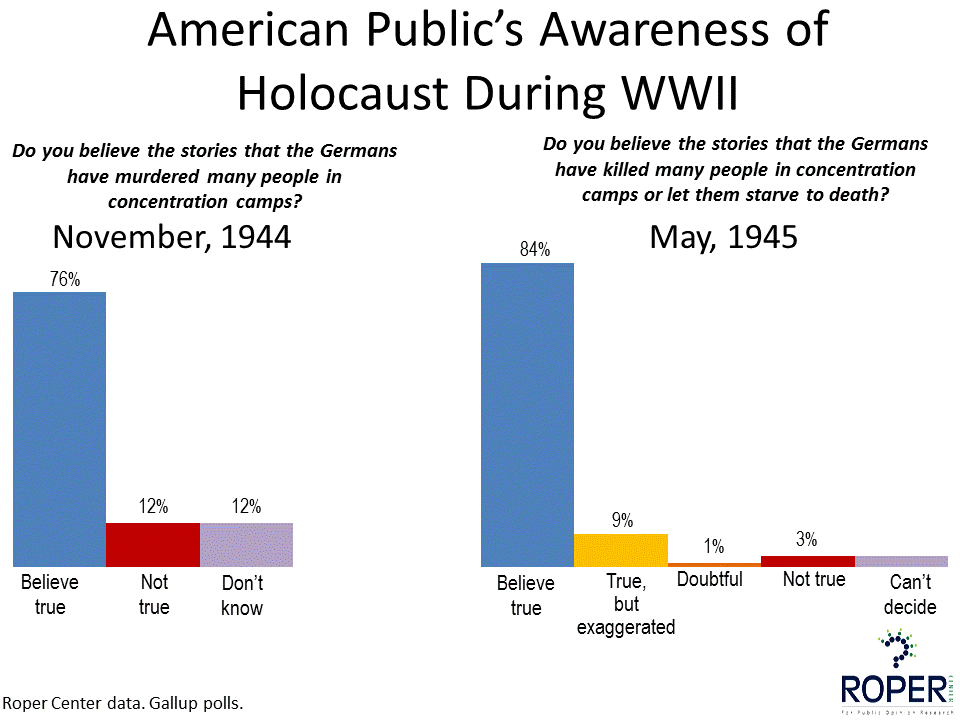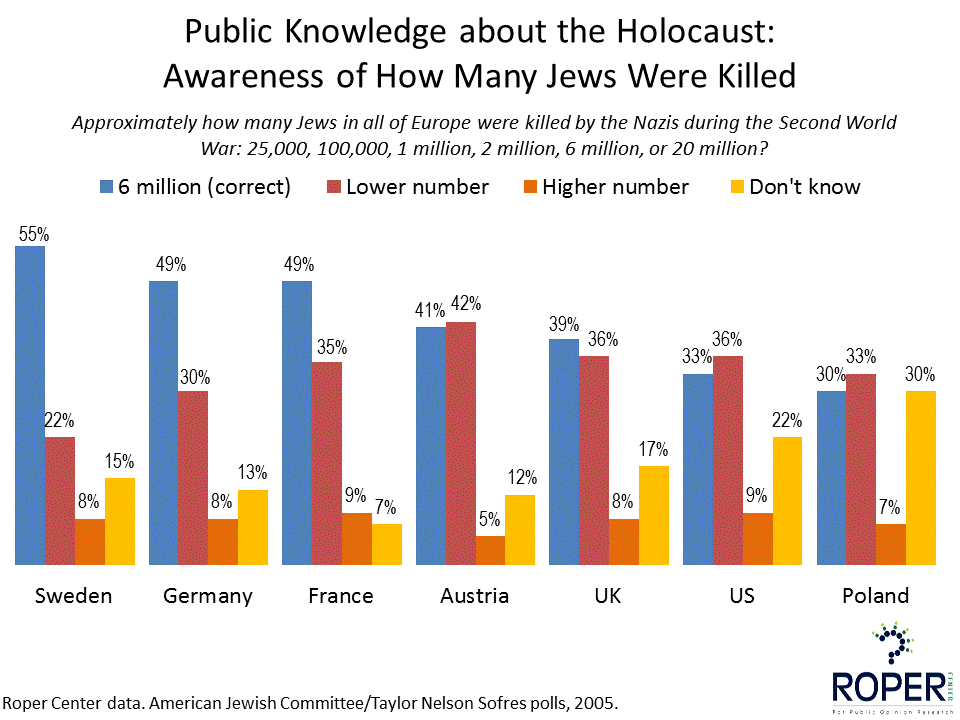Seventy-two years ago this week, the Soviet army liberated prisoners at the Auschwitz concentration camp. How much did Americans at the time understand about the horrors that were unfolding in Europe, and how much do they know about the Holocaust today? A look at what public opinion polling tells us about Americans and the Holocaust, from the Roper Center for Public Opinion Research archives:
US attitudes about Nazi Germany before the War
The first polling questions about the suffering in Nazi Germany were asked before the war began. In 1938, Gallup asked Americans if they approved of the treatment of Catholics and Jews in Germany. Disapproval was overwhelming: 94% disapproved of the treatment of Jews, and 97% of the treatment of Catholics. But this disapproval did not lead to strong support of measures meant to help those suffering under the Nazi regime. A majority of 57% in a 1938 Gallup poll did support the temporary withdrawal of the American ambassador to Germany as a protest against Nazi treatment of Jews and Catholics, but 23% did not, and 20% didn’t have an opinion. Only 39% supported having the U.S. government contribute money to assist Jewish and Catholic exiles in relocating to Africa or South America. Just 21% supported allowing increased numbers of Jewish exiles to come from Germany to live in the U.S.
When the unbelievable had to be believed
In the summer of 1944, the New York Times ran reports on the mass killing of Jewish people under the Nazis. In November of that year, 76% of Americans in a Gallup poll said they believed the stories that Germans had murdered many people in concentration camps. When respondents were asked to estimate the number of people who had been killed in these camps, however, it was clear that the extent of the atrocity was not yet understood. While 33% refused to venture a guess, 36% thought the number killed was under 100,000, 8% between 100,000 and 1,000,000, and 24% thought a million or more. By May of 1945, more of the public had come to accept the truth of what had happened, though some still held doubts. Eighty-four percent of Americans in a Gallup poll said they believed reports that the Germans had killed many people in concentration camps or let them starve to death. In this poll, the median estimate of the number killed in the camps was 1 million, still far below the actual numbers as estimated by today’s historians.
Were the leaders or the people to blame?
A 1944 NORC survey found that 40% of Americans believed that German people should be blamed for the cruelties to religious groups, the mass killings in occupied countries, and the tortures in concentration camps. When given the choice of laying blame with both the leaders and the German people in a 1945 NORC survey, 52% said both bore the blame, while 42% said only the Nazi leaders, and 4% just the people.
Should the pictures be shown?
Although historically there have often been debates over the appropriateness of widespread distribution of photographs that provide brutal evidence of atrocities, Americans after WWII overwhelmingly wanted the atrocities of concentration camps to be exposed with photographic evidence. Nearly nine in ten in a 1945 Gallup poll said they thought pictures of “the horrible things that have happened in prison camps run by Germans” should be shown to all the German people, and 87% to all German POWs in the States. Eighty-three percent wanted to see the pictures for themselves. Six in ten thought these pictures should be shown in movie theaters throughout the US.
Recent knowledge of the Holocaust
Despite the enormity of the Holocaust, and the many books, movies, museums and memorials aimed at ensuring remembrance, Americans in more recent years have shown surprising ignorance of what happened under the Nazis. A 1985 Time/Yankelovich, Skelly & White found that only 69% of respondents could say what the Holocaust was in their own words. When Americans were asked by the American Jewish Committee/Taylor Nelson Sofres in 2005 how many Jews died in the Holocaust, just 33% were able to select the correct number, while only 44% were able to identify Auschwitz, Dachau and Treblinka as the names of concentration camps. This survey was fielded in multiple countries, and differences in knowledge varied significantly. Perhaps aware that that U.S. public knowledge about the Holocaust is weaker than it should be, a strong majority of Americans support education in this area. In a 2006 Genocide Intervention Network/Greenberg Quinlan Rosner Research poll, 79% supported mandatory Holocaust education in public schools.
Roper Center data. Collections cited include Gallup 1937, 1938, 1944, 1945; NORC, 1944, 1945; Time/Yankelovich, Skelly & White, 1985; American Jewish Committee/Taylor Nelson Sofres, 2005; Genocide Intervention Network/Greenberg Quinlan Rosner Research, 2006.
View more polling data on the Holocaust.
Date Published: January 26, 2015

